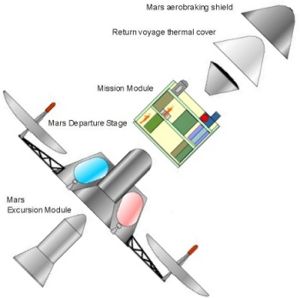
Home - Search - Browse - Alphabetic Index: 0- 1- 2- 3- 4- 5- 6- 7- 8- 9
A- B- C- D- E- F- G- H- I- J- K- L- M- N- O- P- Q- R- S- T- U- V- W- X- Y- Z
TRW Mars
 TRW Mars Credit: © Mark Wade |
Status: Study 1963. Gross mass: 650,000 kg (1,430,000 lb). Height: 17.80 m (58.30 ft).
It found that this approach could reduce the expedition mass in low earth orbit by a factor of five, allowing chemical propulsion to be used.
NASA Ames issued a contract to TRW in 1963 to study a non-nuclear manned mission to Mars with minimum weight achieved through maximum mass reduction measures and innovative mission scenarios. A landing date in 1975 was assumed. Aerobraking on arrival at Mars and on return to earth was the biggest driver in achieving the weight reduction goal.
The mission profile was a fast opposition-class mission of 400 to 450 days, with ten days spent on the surface. The spacecraft was shaped like an Atlas nose cone with a conical tip, cylinder, and aft skirt. The 11.4 metric ton Mars Excursion Module used the same shape. A Martian atmosphere with a surface pressure 10% that of earth was assumed.
The mission profile was as follows:
- A total of seven Saturn V launches would be required to assemble the spacecraft in low earth orbit: One for the earth departure stage; one for the Mars departure stage; one for the manned Mission Module; and four tankers to refuel the earth departure stage.
- Trans-Mars injection using the liquid oxygen/liquid hydrogen earth departure stage.
- A 152 m long tether would be deployed between the Mission Module and the expended earth departure stage. The spacecraft and rocket stage would be rotated using this tether to provide artificial gravity during the flight to Mars. Two solar thermal collectors, each with an area of 70 square meters, would provide electrical power during the coast.
- Separation of the booster stage tether, retraction of solar collectors and antennae.
- Aerobraking into an elliptical orbit around Mars. Redeployment of the solar collectors.
- Propulsive raising of the perigee of the orbit out of the atmosphere to establish a stable parking orbit.
- After survey of the surface, separation of the Mars Excursion Module for a ten day exploration of the surface.
- Trans-earth injection using the Mars departure stage.
- Artificial gravity during the coast back to earth using a tether between the Mission Module and the expended Mars departure stage.
- A Venus flyby to reduce earth return velocity. The earth return velocity without the swing-by was tremendous - 20 km/sec for a 1975 mission, 21.3 km/sec for a 1980 mission. No known re-entry vehicle configuration could handle such speeds. Therefore TRW proposed using a Venus swing-by to modify the solar orbit of the returning spacecraft, which would reduce re-entry velocity to a manageable 14 km/sec. TRW was able to identify Venus swing-by trajectories for every Mars launch opportunity.
- Separation of the Earth Return Vehicle from the Mission Module and return to earth by direct re-entry into the earth's atmosphere. Apollo command-module type shapes or more advanced lifting-body shapes were considered. The Earth Return Vehicle design developed by TRW was a half-cone lifting body, 6.5 m long, 1.97 m high, and with a span of 3.84 m.
The study concluded that an all-chemical 1975 mission using a conventional rocket braking scenario would weigh 3250 metric tons, while the TRW aerobraking spacecraft would weigh only 650 metric tons.
TRW Mars Expedition Mission Summary:
- Summary: First Mars expedition detail design to minimize mass through use of aerobraking.
- Propulsion: LOX/LH2
- Braking at Mars: aerodynamic
- Mission Type: opposition
- Split or All-Up: all up
- ISRU: no ISRU
- Launch Year: 1975
- Crew: 6
- Outbound time-days: 200
- Mars Stay Time-days: 10
- Return Time-days: 220
- Total Mission Time-days: 450
- Total Payload Required in Low Earth Orbit-metric tons: 650
- Mass per crew-metric tons: 108
- Launch Vehicle Payload to LEO-metric tons: 100
- Number of Launches Required to Assemble Payload in Low Earth Orbit: 7
- Launch Vehicle: Saturn V
Crew Size: 6.
Family: Mars Expeditions. Country: USA. Propellants: Lox/LH2. Agency: TRW. Bibliography: 49, 591.
 | TRW Mars Exploded Credit: © Mark Wade |
Back to top of page
Home - Search - Browse - Alphabetic Index: 0- 1- 2- 3- 4- 5- 6- 7- 8- 9
A- B- C- D- E- F- G- H- I- J- K- L- M- N- O- P- Q- R- S- T- U- V- W- X- Y- Z
© 1997-2019 Mark Wade - Contact
© / Conditions for Use